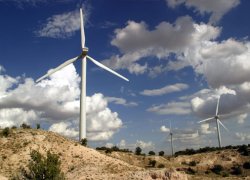Everything is Big There: Texas
Now Tops in Wind
Aug 25, 2007 - Janis Mara - Oakland Tribune
 Recent
Texas developments suggest that California's lead
in one alternative energy area may be gone with
the wind. The wind turbine, that is.
Recent
Texas developments suggest that California's lead
in one alternative energy area may be gone with
the wind. The wind turbine, that is.
Last year, for the first time ever, an industry
association reported that Texas surpassed California
as the country's No. 1 generator of wind energy.
Not only did the Lone Star State blow past the Golden
State again in this year's report, but Texas regulators
in July voted to designate eight zones for production
of some 20,000 megawatts of wind energy.
"Texas has much better wind resources. Based on
that alone, it is likely Texas will stay ahead of
California," said Case van Dam, a professor at the
University of California, Davis who is also director
of the California Wind Energy Collaborative. Also,
Texas is moving more quickly than California to
take advantage of its wind resources, van Dam said.
The development is a bit of a twist given that
California, with its Million Solar Roofs plan and
other programs, is a national leader in conservation
efforts, while Texas has long been associated with
old-school energy sources such as oil and natural
gas.
Texas' lead is increasing. In 2005, Texas led California
by 47 megawatts in installed wind energy; in 2006,
it led by 407 megawatts, according to the annual
U.S. wind power rankings of the American Wind Energy
Association. One megawatt is enough electricity
to power 750 California homes during peak demand.
The association reported that Texas had a capacity
of 2,768 megawatts as of Dec. 31, 2006. California
had a capacity of 2,361 megawatts.
"Texas is wowing
everyone with those numbers," said Christine Real
de Azua, a spokesperson for the association.
But
it's not as though California is losing its position
as a conservation leader, she said.
"California
is succeeding in keeping a cap on electricity consumption,
so the demand for electricity isn't growing as quickly
as in Texas," Real de Azua said. "You (Californians)
are keeping a lid on demand with increased efficiency,"
she said.
Energy consumption per capita in California
has remained flat "for a couple of decades," agreed
Michael Webber, associate director of the Center
for International Energy and Environmental Policy
at the University of Texas, Austin.
The average
Californian consumes 233 million Btus of energy
-- which includes lighting; heating and cooling
at home; driving; and eating -- in one year, according
to the U.S. Energy Information Administration. In
contrast, the average Texan consumes 560 Btus, according
to the EIA. The average American consumes 340 million
BTUs.
One of the reasons Texas is pulling ahead
is because of how quickly it is installing new wind
energy farms and enacting pro- wind-energy regulations,
experts said.
"It's ironic," said Webber. "Texas
hasn't put as many environmental protections in
place; you don't have to do environmental impact
reports, for example, and this has given us the
ability to build wind."
An example of the support
Texas governing bodies have lent to wind energy:
In July, the Public Utility Commission of Texas
designated competitive renewable energy zones in
West Texas and the Panhandle for production of some
20,000 megawatts of wind energy.
California energy
mavens aren't concerned over Texas' new position
as the wind energy leader for a variety of reasons.
Some say it's still possible to catch up.
"The California
Public Utilities Commission just approved the first
phase of approvals for a transmission line that
will add 6,000 megawatts of electric power to the
grid from Tehachapi," said Amy Morgan of the California
Energy Commission. (The grid is the system that
distributes electricity all over the state.)
California
has four main wind resource areas: Altamont Pass,
Tehachapi Pass, San Gorgonio Pass and Rio Vista
in Solano County.
Others see the issue in terms
of the big picture.
"We're not in competition with
Texas to see who can have the most wind power. We're
in competition with ourselves to see how much wind
energy we can produce," said Gregg Fishman of California
Independent System Operator, which is in charge
of California's energy grid.
"Texas certainly is
larger, they have greater geographic areas available.
That's one thing they're using to their advantage
as well.
"More power to them," Fishman said.
Originally
published by Janis Mara, BUSINESS WRITER. Source:
Oakland Tribune